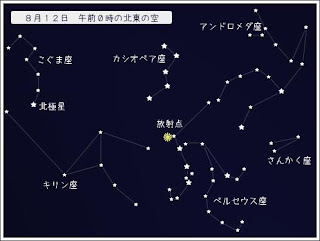Perseid Shower Tonight

There is a very good chance to see meteors tonight, if the sky is clear. The Perseid meteor shower has been observed regularly for a very long time, and was first noted in the "Far East" (don't you just love the old-fashioned term!).
The shower is visible from mid-July each year, with the greatest activity between August 8 and 14, peaking about August 12. During the peak, the rate of meteors reaches 60 or more per hour.
- Wikipedia
Image from hoshifuru.jp who notes that the peak will be around 2-3 AM on August 13 here in Japan. Look towards north-east.
流れ星 (nagare boshi) is the Japanese word for falling star, while meteor is called 流星 (ryuusei). 星 (hoshi or -boshi or -sei) is of course "star" so I was surprised to see that kanji in the proper word for meteor, as they are not stars at all.
What Wikipedia means by "Far East" is more clear from the link to meteorshoweronline.com:
The earliest record of Perseid activity comes from the Chinese annals, where it is said that in 36 AD "more than 100 meteors flew thither in the morning." Numerous references appear in Chinese, Japanese and Korean records throughout the 8th, 9th, 10th and 11th centuries, but only sporadic references are found between the 12th and 19th centuries, inclusive. Nevertheless, August has long had a reputation for an abundance of meteors. The Perseids have been referred to as the "tears of St. Lawrence", since meteors seemed to be in abundance during the festival of that saint in Italy on August 10th; however, credit for the discovery of the shower's annual appearance is given to Adolphe Quételet (Brussels, Belgium), who, in 1835, reported that there was a shower occurring in August that emanated from the constellation Perseus.

Comments